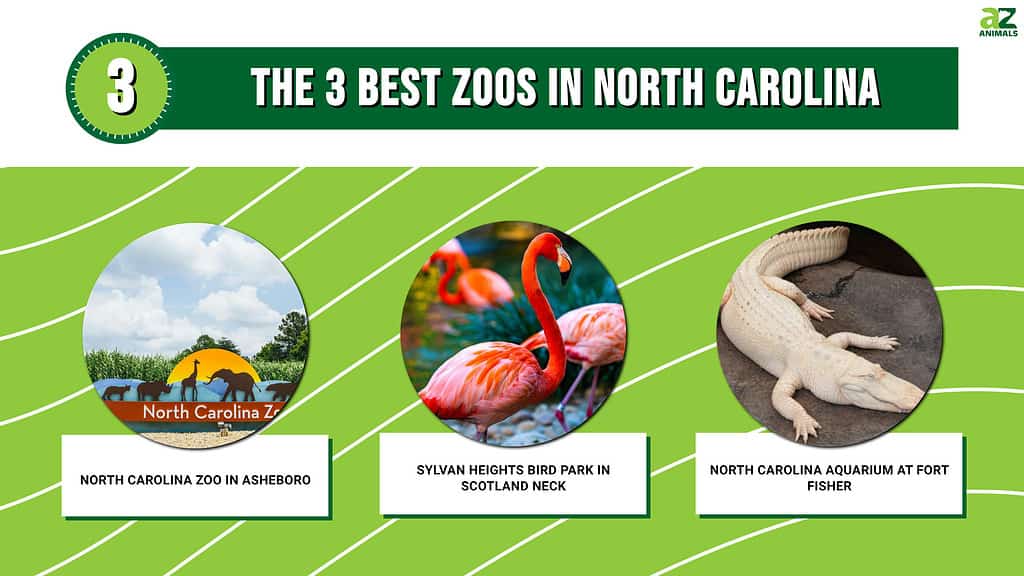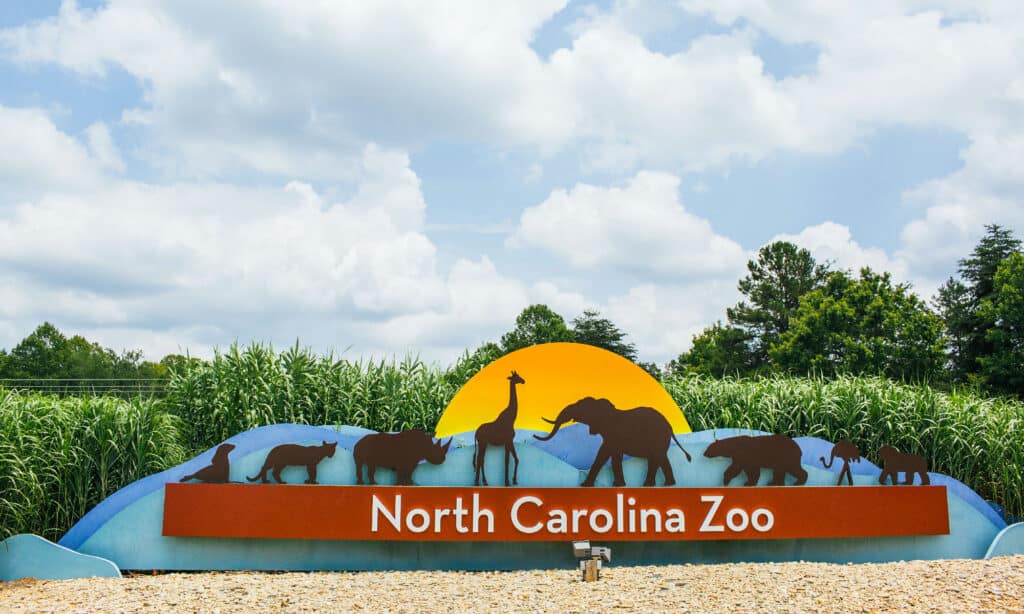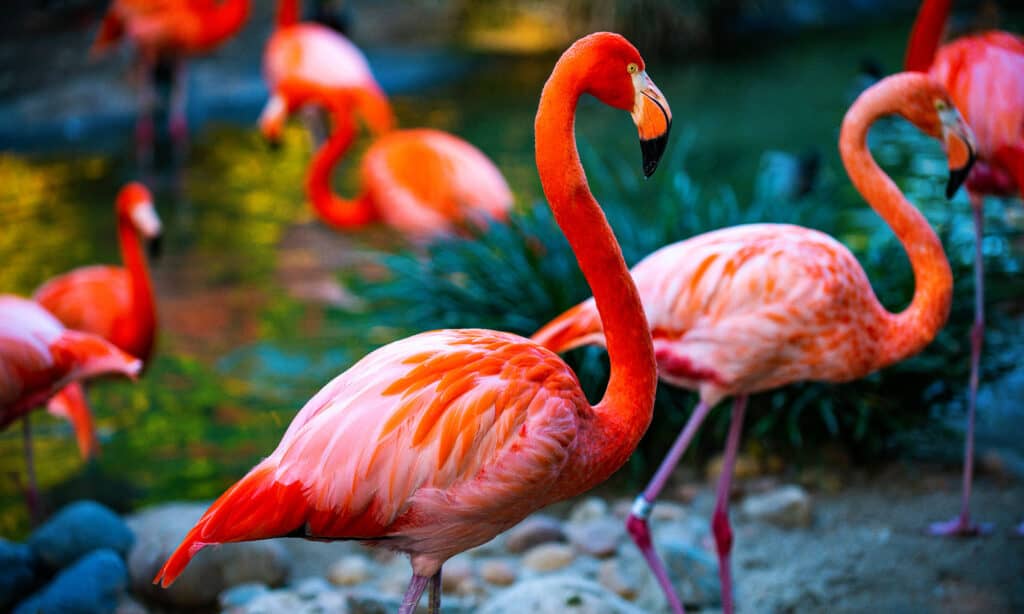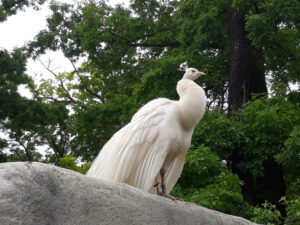With warmer weather on the horizon, you may be looking for the best way to take advantage of the day. If you’re an animal lover, you might have wondered about the best zoos in North Carolina. After all, humans aren’t the only ones growing more active!
If this sounds like you, keep reading below to learn more about the best zoos in North Carolina.
3 Best Zoos in North Carolina
North Carolina is home to several zoos, bird parks, and aquariums. Each one has its benefits, and although they may carry similar animals, not all are created equal. Below, you’ll find information on 3 of the best zoos in North Carolina.

1. North Carolina Zoo in Asheboro
Situated almost directly between Charlotte and Raleigh, the North Carolina Zoo in Asheboro is one of the most popular zoos in the state. It also happens to be one of only two state-funded zoos in the entire country, with the other being the Minnesota Zoo.
The North Carolina Zoo is home to over 1,800 animals. Currently, the zoo is divided into two main sections: North America and Africa. In these sections, you’ll be able to explore the native species. A third expansion is set to open in 2026. The new section will cover the continent of Asia. This 10-acre expansion will introduce a variety of new faces to the zoo, including tigers and Komodo dragons!
In the meantime, however, you’ll be able to learn about more than 250 different species at this zoo. In the African exhibit, you can find iconic species such as African elephants, giraffes, African lions, southern white rhinoceroses, and gorillas. With just a quick stroll over to the North American side of the zoo, you can enjoy watching species like polar bears, cougars, and red wolves.

The North Carolina Zoo is the largest natural habitat zoo, with over 1,800 animals.
©ZikG/Shutterstock.com
Before You Go
If you want to get the most out of the North Carolina Zoo, it’s best to plan your visit to take all day. You can arrive at the zoo as early as 9 in the morning, and the last entry is one hour before closing. Much of the zoo is on paved trails, with a trolley transporting you between the continents. As a result, almost all of the zoo is accessible, although some areas with rough terrain may be difficult for those in wheelchairs or with strollers.
2. Sylvan Heights Bird Park in Scotland Neck
If you happen to be visiting the Triangle, then Sylvan Heights Bird Park is just an hour and a half drive away. This park is open from Tuesday to Sunday, with the doors opening at 9 in the morning.
Sylvan Heights Bird Park is a conservationist’s dream. Here, you’ll find breeding populations of some of the rarest species of waterfowl in the world. For many of the rare species of birds at the park, there are less than 250 individuals remaining in the wild. As a result, Sylvan Heights Bird Park’s breeding program is one of their last chances to prevent extinction and allow countless future generations to enjoy these amazing species.
Spread across 28 acres, Sylvan Heights is home to around 2000 different birds ranging from native waterfowl to exotic species. In the walk-through aviaries housing these birds, you’ll find species from every continent but Antarctica, including flamingos, toucans, and more. Some of the species in Sylvan Heights Bird Park include the Abyssinian ground hornbill, scarlet ibis, white-faced whistling duck, and the blue and gold macaw.
Sylvan Heights Bird Park also offers a unique, close-up experience known as “The Landing Zone.” Here, you’ll be able to interact directly with hundreds of birds, with bird food available for purchase as well. Some of the species in the Landing Zone include parakeets, flamingos, pigeons and doves, and parrots. Some of the birds, like flamingos, will eat out of your hand, while smaller species, like parakeets, may decide to use you as a perch!

At the Sylvan Heights Bird Park Landing Zone, you can see
parakeets
, flamingos, pigeons and doves, and parrots.
©Volodymyr TVERDOKHLIB/Shutterstock.com
Before You Go
Unless you’re bringing a large group, such as for a field trip, you won’t need to make a reservation to enter the park. Sylvan Heights Bird Park recommends at least two hours to explore the entire park, although many people will stay for half the day or longer. This ensures that you have time to visit each exhibit while also getting to enjoy the Landing Zone, which is free with admission.
The trail is around one mile long, with an abundance of benches and places to sit if you need to rest. It is also wheelchair and stroller accessible, as are the aviaries.
3. North Carolina Aquarium at Fort Fisher
The North Carolina Aquarium at Fort Fisher is located on Kure Beach, neighboring the Fort Fisher State Historic Site.
When you first enter the aquarium, you’ll enter into a large room similar to a greenhouse. Here, you’ll notice several different tanks filled with a variety of freshwater fish. However, the North Carolina Aquarium at Fort Fisher has more to offer than just fish! You’ll also find free-range quail wandering this part of the aquarium, along with exhibits featuring otters, newts, and their resident albino American alligator, Luna!
After this, you will have the opportunity to take a professional picture for an additional cost. Flash-free photography is welcomed throughout the aquarium, however.
The next portion of the aquarium is indoors in a temperature-controlled building. In order to help highlight the best of what these tanks have to offer, it is often dim in this area, so be sure to watch your step. Aside from the Megaladon mouth with which you can take your picture, the North Carolina Aquarium star at Fort Fisher is their Cape Fear Shoals habitat. This 235,000-gallon aquarium tank is filled with sharks, stingrays, a moray eel, a sea turtle, and several other species. It has two floors, as well as a back area, leaving little to no areas unseen in this amazing exhibit.

At North Carolina Aquarium at Fort Fisher, you can see a rare albino alligator.
©one5zero/Shutterstock.com
Before You Go
The North Carolina Aquarium at Fort Fisher is open from 9 in the morning to 5 in the afternoon every day. Make sure to reserve your tickets in advance to enter the aquarium, no matter the size of your group. There are indoor and outdoor exhibits, with the latter featuring trailings wrapping around a water feature filled with turtles and local waterfowl. If you plan on enjoying the outside portion of the aquarium, where you can find their resident bald eagle, make sure to plan accordingly. This means checking the weather and wearing the proper shoes.
Best Time to Visit the Zoo in North Carolina
Many of the zoos in North Carolina are open year-round, although they may have seasonal hours that vary. However, the best time to visit the zoo is during the spring or fall, such as from March to May or from September to November.
North Carolina can reach extreme temperatures during the winter and the summer. Not only can this be uncomfortable to walk in, but it also means that many of the animals that you would normally see won’t be active.
If you’re looking to plan a trip to one of the many zoological parks in North Carolina and the forecast is predicting bad weather that may not be prime for you or the animals, consider visiting an indoor facility instead. The North Carolina Aquarium at Fort Fisher does have outside components, such as its bald eagle exhibit, but it also has many indoor exhibits to explore.
How to Prepare to Visit the Zoo
One of the best ways to prepare to visit some of the zoos in North Carolina is to learn more about the facility you’ll be visiting. Some zoos require more walking than others, and there are different time constraints. For example, the North Carolina Zoo in Asheboro is an almost entirely outdoor adventure that can take all day. The aquarium found at Fort Fisher, however, is mostly indoors and can be covered in just a few hours.
The setting and rules surrounding the zoo will determine how you need to prepare. This includes whether you need to bring snacks and water bottles, your clothes, and what shoes will be most comfortable. It’s also important to learn if a zoo is accessible if you need a wheelchair or stroller.
The photo featured at the top of this post is © vladivlad/Shutterstock.com
Thank you for reading! Have some feedback for us? Contact the AZ Animals editorial team.






